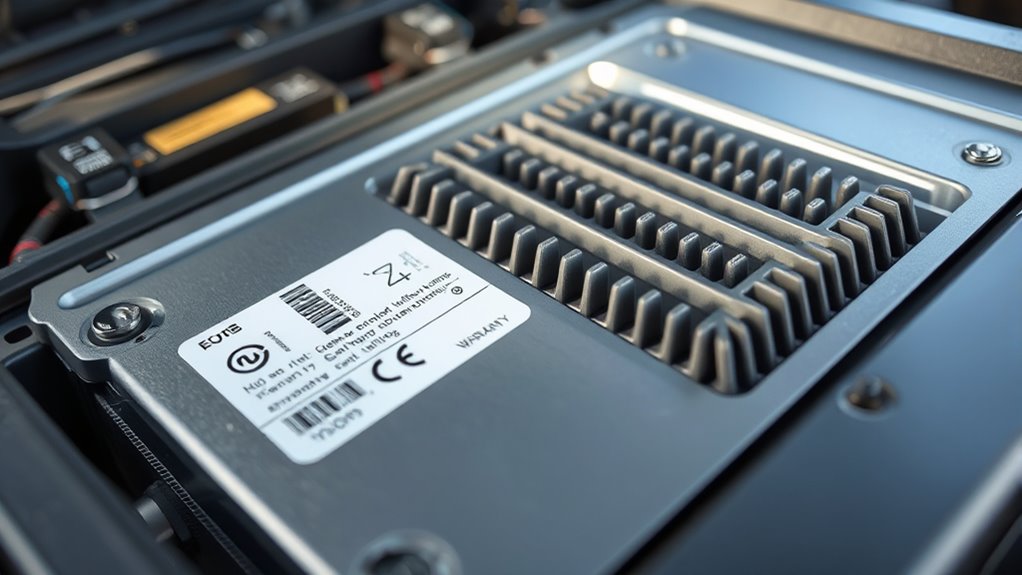Your E‑Transit’s battery comes with an 8-year or 100,000-mile warranty that covers defects and major capacity loss. Over time, your battery’s capacity naturally declines, reducing your range, especially with frequent fast charging or extreme temperatures. To extend battery life, follow recommended charging practices and keep an eye on capacity trends. Understanding how your battery degrades helps you plan maintenance and maintain vehicle reliability—more details will help you stay ahead of potential issues.
Key Takeaways
- The E‑Transit battery warranty typically lasts 8 years or 100,000 miles, covering defects and excessive capacity loss.
- Capacity loss due to aging reduces range over time but usually remains above 70% after several years.
- Fast charging and extreme temperatures accelerate battery degradation; proper charging practices help extend lifespan.
- Monitoring battery health through diagnostics enables early detection of capacity decline and planned maintenance.
- Following recommended usage and charging guidelines ensures long-term reliability and preserves vehicle value.

Understanding your E‑Transit’s battery warranty and how its performance degrades over time is essential for managing your vehicle effectively. When you invest in an electric van, knowing what the warranty covers helps you plan for potential issues and avoid unexpected costs.
Typically, Ford offers a battery warranty that covers defects and excessive capacity loss for a specific period or mileage—whichever comes first. For the E‑Transit, this warranty usually spans around 8 years or 100,000 miles, whichever comes sooner. This coverage generally ensures that if your battery develops manufacturing defects or loses capacity beyond a certain threshold, Ford will repair or replace it.
Knowing these terms helps you gauge the long-term reliability of your vehicle, especially if you depend on it for daily operations.
Understanding your battery’s warranty and capacity loss helps ensure reliable daily operations.
Battery performance naturally declines over time, primarily due to chemical aging and repeated charge cycles. When you first get your E‑Transit, the battery operates at its maximum capacity, providing the range and power you expect. As months pass and miles accumulate, you’ll notice a gradual reduction in range. This isn’t sudden or alarming but a normal part of battery aging.
The key is understanding that capacity loss affects how far you can go on a single charge, but it doesn’t mean your vehicle will stop working. Most batteries retain a significant portion of their capacity even after several years, often around 70-80%. However, if you notice a sharp decline or if your vehicle’s range drops below the warranty threshold, it’s worth consulting Ford or a certified technician to evaluate your battery’s health.
Degradation rates can vary depending on your driving habits, climate, and charging practices. Frequent fast charging, for example, can accelerate capacity loss because it stresses the battery more than regular slow charging. Extreme temperatures—hot or cold—also impact battery longevity, making it essential to park in shaded or insulated areas and follow recommended charging guidelines.
To maximize your battery’s lifespan, avoid letting it discharge completely regularly and try to keep it within a moderate charge range, typically between 20% and 80%. Monitoring your vehicle’s battery health through Ford’s diagnostics tools or telematics can give you early warning signs of capacity decline, allowing you to plan for maintenance or replacements well before the battery reaches the end of its useful life. Regular maintenance and monitoring can help optimize your battery’s longevity and performance over time.
Frequently Asked Questions
How Does Climate Affect E-Transit Battery Lifespan?
Climate markedly impacts your E-Transit battery lifespan. Hot temperatures accelerate battery degradation by increasing chemical reactions inside, leading to faster capacity loss.
Cold climates can reduce your battery’s efficiency and range temporarily, though they don’t cause long-term damage if managed properly.
To protect your battery, avoid exposing it to extreme heat or cold for extended periods, and follow manufacturer recommendations for climate-specific care to extend its life.
Can Battery Degradation Be Reversed or Improved Over Time?
Battery degradation can be improved, but it can’t be fully reversed. You can help prolong your battery’s life by practicing proper charging habits, avoiding extreme temperatures, and regularly maintaining your vehicle.
While some capacity loss might be inevitable over time, these proactive practices can help slow degradation and keep your E-Transit running efficiently longer.
What Are Signs of Early Battery Failure in E-Transit?
You might notice reduced driving range, slower charging times, or unexpected power loss as signs of early battery failure in your E‑Transit.
Other indicators include frequent error messages related to the battery system or overheating during charging or operation.
Keep an eye on your vehicle’s performance and dashboard alerts.
Address these issues promptly by consulting a technician, as early detection can prevent more serious damage and help maintain your vehicle’s reliability.
How Do Different Driving Habits Impact Battery Longevity?
You might think gentle driving always saves your battery, but aggressive habits like rapid acceleration and hard braking actually hurt its longevity more.
Consistent high speeds and frequent quick charges can accelerate degradation.
To extend your E-Transit’s battery life, drive smoothly, maintain steady speeds, and use slower charging methods when possible.
Small changes in your driving style can make a big difference in how long your battery lasts and performs.
Are There Aftermarket Solutions to Extend Battery Life?
Yes, there are aftermarket solutions to extend your E‑Transit battery life. You can install advanced battery management systems or cooling kits that help regulate temperature and reduce degradation.
Some users opt for software updates or specialized charging equipment to optimize battery performance.
However, always consult with professionals to ensure compatibility and avoid voiding your warranty. Proper maintenance and cautious charging habits also greatly contribute to prolonging your battery’s lifespan.
Conclusion
Now that you understand the battery warranty and degradation basics for your E‑Transit, you can confidently keep your van running smoothly. Just remember, even the most legendary vehicles like the Knight Rider faced some wear and tear; your E‑Transit isn’t immune either. Proper care and knowing your warranty details help you avoid surprises down the road. Stay proactive, and your electric journey will be as smooth as a well-oiled machine—no DeLorean needed!









